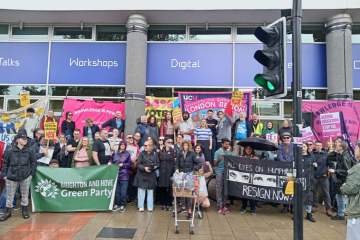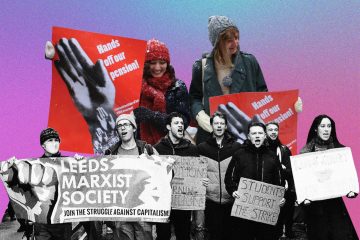The streets of London were filled yesterday – Wednesday 11th December – with students angry against the presence of police on university campuses and the increasingly violent use of force by the police against student protests – force used to push through the Coalition’s austerity measures against any resistance.
Estimates of the numbers present on the demonstration, which began outside the University of London Union (ULU) in Bloomsbury at 2pm, vary from around 2000-4000. Regardless of the exact numbers, it is clear that this was a large protest over an issue that students are rightly concerned about.
The police and university management, in applying such brutal and excessive measures against student protests last week, with large scale arrests and indiscriminate violence used to clear an occupation of the University of London (UoL) and a subsequent demonstration of 200 students, have helped to provoke the anger of students and bring more people out onto the streets.
Stop police repression by building a mass movement
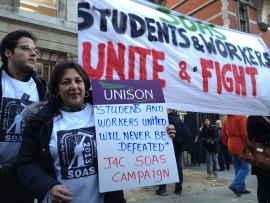 The visible size of yesterday’s protest clearly settled any nerves and provided calm to those present; despite advice on leaflets from more anarchistic elements to “mask up” and “build barricades” in order to prevent “intimidation” by police, the vast majority of those present on the demonstration felt no need to conceal their identities. Such “advice”, far from helping to prevent intimidation, only serves to have the opposite effect: a sea of masked-up activists armed with shields sets a confrontational atmosphere from the beginning and only increases the anxiety and apprehension of ordinary students, alienating a broader layer of those who would otherwise be keen to join the protest.
The visible size of yesterday’s protest clearly settled any nerves and provided calm to those present; despite advice on leaflets from more anarchistic elements to “mask up” and “build barricades” in order to prevent “intimidation” by police, the vast majority of those present on the demonstration felt no need to conceal their identities. Such “advice”, far from helping to prevent intimidation, only serves to have the opposite effect: a sea of masked-up activists armed with shields sets a confrontational atmosphere from the beginning and only increases the anxiety and apprehension of ordinary students, alienating a broader layer of those who would otherwise be keen to join the protest.
Instead, however, students yesterday waved placards, shouted slogans, and marched confidently – first around the UoL campuses and later through the streets of central London – in defiance of the police. The initial route of the march, with thousands of students weaving around the main UoL site and its constituent universities, was symbolic of the main demand of the protest: that universities should be a place for learning and education, not for police brutality and repression.
Throughout the demonstration, police kept their distance, despite a noticeably large number of police vans in the streets surrounding ULU before the protest. Despite the largely illegal nature of the protest, which swept past the Royal Courts of Justice, Trafalgar Square, and Downing Street, the police did nothing to intervene and the demonstration remained peaceful throughout.
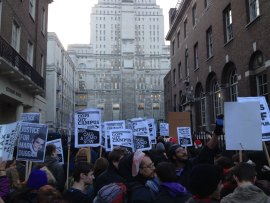 This proves that the key to stopping police repression of protests is for them to have a mass character. The police – whose reputation in society is hardly pristine at the current time, due to countless scandals in previous years – might be able to skirmish with isolated, small groups of hardened activists; but using forceful tactics against a mass demonstration of ordinary students would have risked sparking off an even bigger movement that would certainly have sympathy amongst a much wider layer of students and workers. One only has to look back at the events of Milbank during the 50,000 strong protest of 2010 – organised by the NUS – to see how powerless the police were in the face of thousands of students occupying the building of the Tory Party headquarters – a symbol of this hated coalition government.
This proves that the key to stopping police repression of protests is for them to have a mass character. The police – whose reputation in society is hardly pristine at the current time, due to countless scandals in previous years – might be able to skirmish with isolated, small groups of hardened activists; but using forceful tactics against a mass demonstration of ordinary students would have risked sparking off an even bigger movement that would certainly have sympathy amongst a much wider layer of students and workers. One only has to look back at the events of Milbank during the 50,000 strong protest of 2010 – organised by the NUS – to see how powerless the police were in the face of thousands of students occupying the building of the Tory Party headquarters – a symbol of this hated coalition government.
Linking up the student movement with that of the labour movement will only help to increase the size and confidence of such demonstrations, and thus further serve to prevent any police repression in the future. Where there might be a need for the defence of a protest against possible attacks and brutal tactics, this should be organised through the student unions and trade unions, and not just left in the hands of irresponsible anarchistic individuals.
Build on every campus: fight for socialist policies
Yesterday’s “Cops off Campus” protest, organised in response to last week’s heavy-handed police tactics, had a festive, fun, and peaceful mood, with thumping music provided throughout by the SOAS Samba Band.
The samba band was only a small part of a strong contingent from SOAS, including trade union banners from SOAS Unison and UCU branches, as well as workers from the “Justice for Cleaners” campaign. This visibly large presence from one of the smaller Bloomsbury universities was thanks to the preparation and organisation of the SOAS Student Union, who had helped to build for the demonstration by linking up with the trade unions from the 3rd December strikes and by hosting a 300-strong meeting the previous evening in SOAS on “Stop the Criminalisation of Protest”, in which numerous contributions from students and workers emphasised the need to build a joint mass movement of students and workers as the only way to prevent police repression of protests.
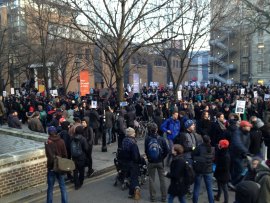 The example of SOAS SU highlights what should be done now on every campus: the student unions and trade unions must link up and call for joint mass action by students and workers, organising a student walkout for the next day of scheduled strike action by university staff. Such action should be built for on every campus by calling mass meetings of students and workers, leafleting lectures, cafes, bars, and common rooms, making announcements in lecturers, writing material in the student newspapers, and through a mass campaign via email and social media. In London, mass meetings should be called by ULU, with delegates from all the individual university student unions and the maximum participation of representation from trade union branches. On a national level, the NUS should be linking up with UCU, Unite, and Unison and throwing their large resources behind the organisation of a national student walkout in support of striking university workers.
The example of SOAS SU highlights what should be done now on every campus: the student unions and trade unions must link up and call for joint mass action by students and workers, organising a student walkout for the next day of scheduled strike action by university staff. Such action should be built for on every campus by calling mass meetings of students and workers, leafleting lectures, cafes, bars, and common rooms, making announcements in lecturers, writing material in the student newspapers, and through a mass campaign via email and social media. In London, mass meetings should be called by ULU, with delegates from all the individual university student unions and the maximum participation of representation from trade union branches. On a national level, the NUS should be linking up with UCU, Unite, and Unison and throwing their large resources behind the organisation of a national student walkout in support of striking university workers.
All of this, however, ultimately requires a political programme. Following the main demand of yesterday’s demonstration – for “cops off campus – it is time now to bring the political issues back to the fore: the privatisation of student debt and the raising of tuition fees; the declining pay and conditions of university staff and outsourced workers; and the general attacks on education due to the Coalition’s austerity programme and the crisis of capitalism. It is around these – ultimately political – demands that the mass of students and workers can be rallied in a struggle against a common enemy: the Tory-led government; the bankers and bosses that they represent; and the crisis-ridden capitalist system that they defend.
The leaders of the trade unions and student unions must build on every campus by rallying students and workers around a socialist programme. The task of revolutionary students is to fight for these socialist policies and explain that there is no alternative other than cuts, attacks, and repression under capitalism. The only alternative for workers and students – in Britain and internationally – is to struggle for the socialist transformation of society.
- No to police brutality.
- No to privatisation of student debt.
- No to attacks on the pay and conditions of university staff.
- For a mass campaign of workers and students on every campus. The NUS, UCU, Unite, and Unison must co-ordinate mass joint national action.
- For a socialist programme to fight the Coalition government and their austerity policies.
